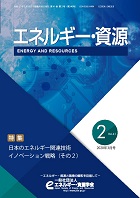All issues

Volume 41 (2020)
- Issue 6 Pages 233-
- Issue 5 Pages 149-
- Issue 4 Pages 121-
- Issue 3 Pages 61-
- Issue 2 Pages 38-
- Issue 1 Pages 1-
Volume 41, Issue 2
Displaying 1-2 of 2 articles from this issue
- |<
- <
- 1
- >
- >|
Research Paper
-
Ryosuke Gotoh, Tetsuo TezukaArticle type: Research Paper
2020 Volume 41 Issue 2 Pages 38-50
Published: 2020
Released on J-STAGE: March 10, 2020
JOURNAL FREE ACCESSEnergy Transition from fossil fuel to renewable energy proceeds in the world. During the energy transition period, existing infrastructure of each district will be considerable restrictions toward the 100% renewable energy society, and replacement strategies of the existing infrastructure will affect the power supply and energy storage system. This paper examines impacts on the future power supply and energy storage system under different strategies of existing power plant replacement in 2020, 2030, 2040 and 2050 in Western Japan for large scale introduction of renewable energy by minimizing total cost with linear planning. The results indicated that when large scale renewable energy was introduced, (1) total cost was minimized in the case of thermal power plant replacement scenario was selected, (2) type of introduced renewable energy was different depends on area, (3) hydrogen was generated as energy storage in the area with high renewable energy potential and transferred to the area with low potential in 2040 and 2050 in the thermal power plant replacement scenario.View full abstractDownload PDF (3926K) -
Hiroyuki Yamada, Takuya Hara, Akira ShichiArticle type: Research Paper
2020 Volume 41 Issue 2 Pages 51-60
Published: 2020
Released on J-STAGE: March 10, 2020
JOURNAL FREE ACCESSThis paper presents the overload status of photovoltaic(PV) and spatial analysis of renewable energy supply based on open source data that includes location on certificated Feed-in Tariff(FIT) capacity , electric transmission networks and solar radiation. As a result of analyzing the open FIT data, it was found that the DC overloading ratio differs by prefecture and by capacity and is mostly 110 to 130 %. The PV introduction amount was about 44 GW while we find that it was estimated that the PV introduction amount considering the DC overloading was about 54 GW. Using open data, it has become possible to estimate PV power generation taking into account DC overloading every hour with a value close to actual results. The PV certification amount taking into account overload in each distribution area varied greatly depending on the distribution area. Areas with large certified capacity exceed 100 MW, but many areas are less than 20 MW.View full abstractDownload PDF (2076K)
- |<
- <
- 1
- >
- >|